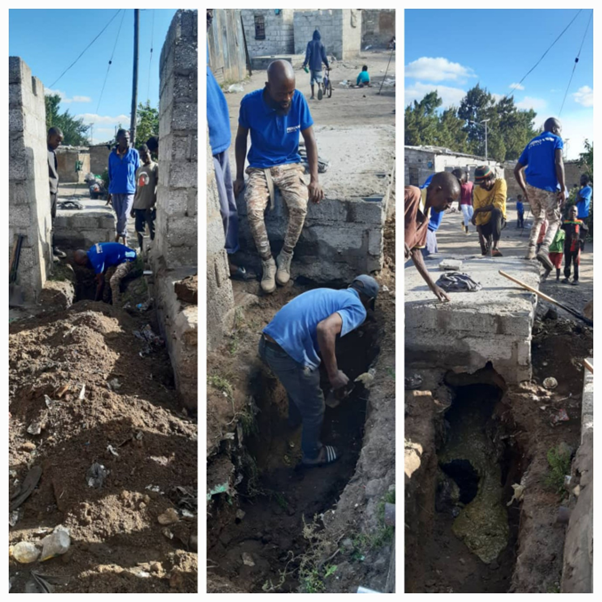July 2025 Pit Emptiers in Zambia: A Look at the Unseen Heroes of Sanitation Chisala D. Meki and Patricia Mubita
Credit: WaterAid/ Nelson Owoicho
July 2025 Pit Emptiers in Zambia: A Look at the Unseen Heroes of Sanitation Chisala D. Meki and Patricia Mubita
They protect public health, yet work in the shadows. With little safety gear, minimal healthcare, and daily exposure to life-threatening hazards, Zambia’s pit emptiers face unimaginable challenges—both physical and social. Based on a study of 196 sanitation workers across 10 provinces, this blog uncovers the dangerous conditions, systemic neglect, and silent resilience of the people who keep our communities clean. Who are these unseen heroes—and what will it take to ensure their dignity and safety? Read on to find out...
Imagine waking up each day uncertain about whether you will find work. This is the harsh reality for many sanitation workers in Zambia, particularly those who empty pit latrines and septic tanks. These individuals, often overlooked and undervalued, play a critical role in public health.
A study by the University of Zambia study investigated the conditions of 196 sanitation workers across ten provinces of Zambia. The majority (99%) of participants were men aged between 25 and 40 with a secondary education. The participants comprised 112 informal manual emptiers, 28 formal manual emptiers, and 56 vacuum tanker drivers. Most workers were part-time employees who secured their jobs through referrals, indicating a reliance on informal networks within the sector.
While over 60% of these workers received safety training and used basic Personal Protective Equipment (PPE) like overalls and gumboots. Formal organizations often provided protective wear, but small-scale and informal emptiers relied on personal purchases. With earnings insufficient to cover transportation and disposal costs, many prioritized family needs over safety. Most lacked proper protective gear, resorting to worn-out work clothes, or even using plastic bags and cloth masks as substitutes for gloves and respirators. The absence of adequate protection significantly increased health risks. A concerning 89% lacked adequate tools, 51% missed crucial medical examinations, and 73% were uninsured. Vaccinations were also limited, with low rates for tetanus (11%), hepatitis (10%), cholera (21%), and typhoid (10%), although COVID-19 vaccination was higher at 42%.
Pit emptying is a hazardous occupation. Workers are exposed to a mix of chemical, biological and physical risks. Inhaling noxious gases from faecal sludge and disinfectant fumes are constant threats, possible cause of respiratory illnesses the major reported ailment. Physical dangers include handling sharp objects like needles, glass and nails, as well as the ever-present risk of pit collapse due to poor construction. Workers may even encounter decomposed animal carcasses and human remains, causing severe psychological distress. The physical demands of manually lifting heavy buckets contribute to chronic health issues like back pain and fatigue.

Informal Emptiers emptying a pit latrine in John Laing Compound Lusaka district Zambia
To make matters worse, these workers endure significant social stigma. Over 60% of respondents reported being ridiculed and blamed for disease outbreaks. This social ostracism, coupled with the hazardous working conditions, has led to high rates of substance abuse as a coping mechanism. Respiratory illnesses were the most common health issues among pit emptiers, followed by diarrhea and fatigue.
The challenges extend beyond the individuals involved. Inadequate infrastructure, such as a lack of designated disposal sites, forces many informal workers to bury waste on-site, posing a significant public health risk. Limited access to transportation and financial constraints further compounds the problem.While Zambia has regulations for sanitation workers, they fall short in addressing the specific needs of pit emptiers, especially those working informally. Improving sanitation worker safety requires a multi-pronged approach. This includes providing essential safety gear, ensuring healthcare access, strengthening regulations, empowering workers through representation, raising community awareness, investing in proper waste disposal infrastructure, and exploring more sustainable business models for sanitation services. These measures are crucial for protecting the health and well-being of sanitation workers and improving overall public health.
-----------------------------------------------------------------------------------------------------------
Acknowledgements: This blog was made possible through the research grant from the Initiative for Sanitation Workers.
Chisala D. Meki and Patricia Mubita, Lecturers and Researchers at the University of Zambia, School of Public Health, Department of Environmental Health, authored this blog. For any questions, contact the authors at cdmeki@gmail.com or chisala.meki@unza.zm
